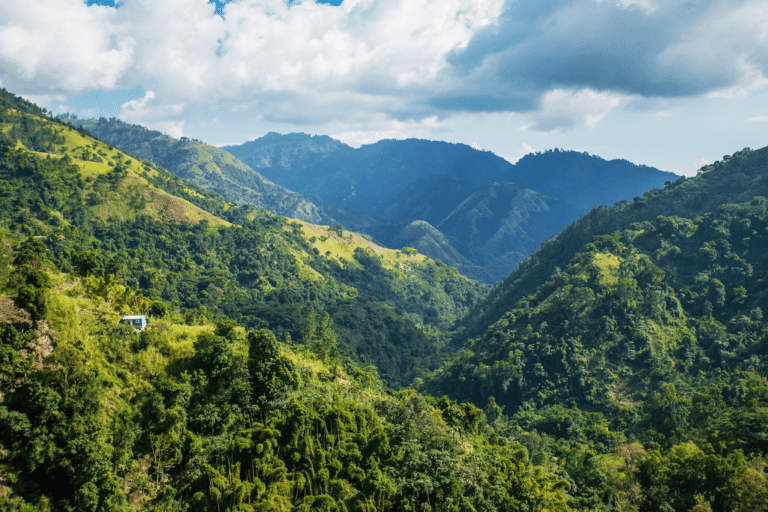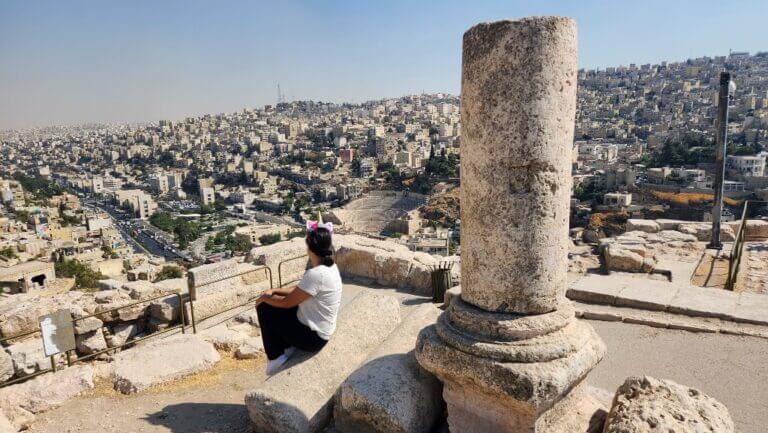20 Things To Do In Stanley Park, Vancouver 2025


Are You Planning To Visit Stanley Park, Vancouver But Don’t Know What To Do There? Look No Further!
There are plenty of things to do in Stanley Park as it is the largest park in Vancouver and one of the largest in North America.
It’s a perfect destination for anyone who loves nature, outdoor activities, and beautiful views.
Whether you’re looking for a peaceful stroll, a scenic bike ride, a family picnic, or a cultural experience, Stanley Park has something for everyone.
It features scenic views of the mountains and the city, beautiful beaches, diverse wildlife, winding trails, and historical landmarks.
Also, Stanley Park is famous for its Seawall, where locals and tourists alike can walk or bike.
In this blog post, we’ll explore some of the best activities and attractions that this iconic park has to offer.
There is a map of Stanely Park at the end which shows the location of all the things I have mentioned.
Recommended Resources:
🏢 Hotels
🚵🏼♀️ Tours
🚘 Car Rental
🩹 Travel Insurance
💧 Water Bottle

Things To Do In Stanley Park
There are many things to do and see in Stanley Park, so let’s start at the beginning.
1. Lost Lagoon
The Lost Lagoon is a man-made body of water located in Stanley Park, Vancouver.
It is the first thing you will see when you enter the park and it is the biggest body of water in Stanley Park.
The lagoon is connected to the ocean via a small inlet and is surrounded by walking paths and greenery.
The Lost Lagoon is home to a variety of wildlife, including ducks, geese, herons, swans, etc.
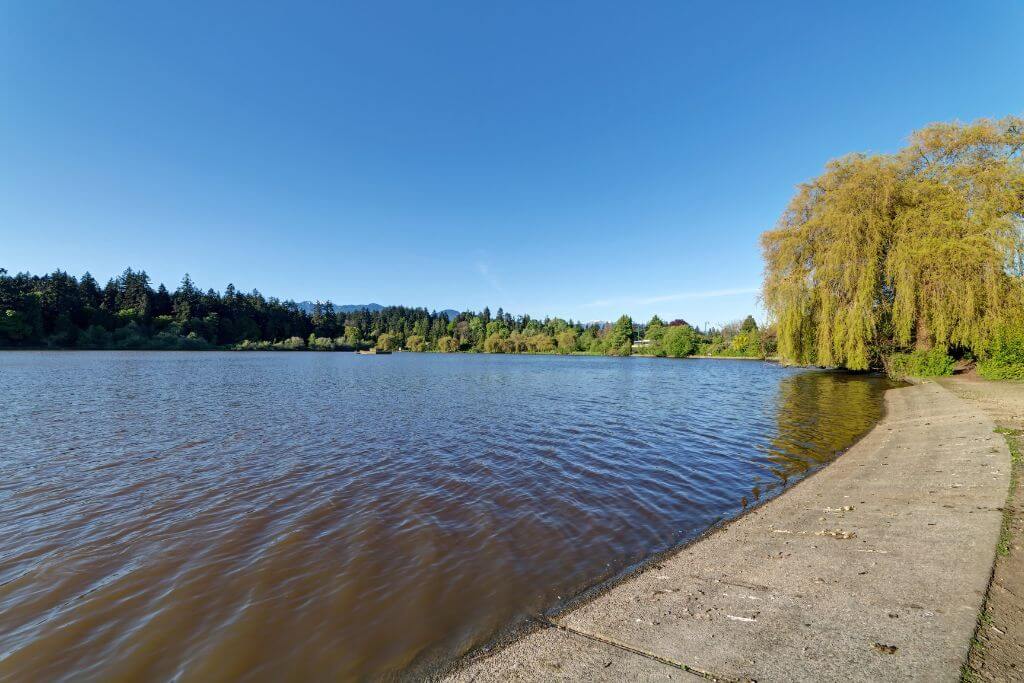
At the center, you can see the Jubilee Fountain which during our visit, was undergoing renovation work and was not on.
There are benches on the banks of the lake where you can sit down and reconnect with nature.
Also, several walking trails around the lagoon offer stunning views of the water and the surrounding forest.
The Lost Lagoon was originally a tidal mudflat, but in the early 1900s, the City of Vancouver created a dam at its entrance to turn it into a freshwater lake.
They landscaped and turned the area surrounding the lagoon into a park, now known as Stanley Park.

Can you swim in the Lost Lagoon?
No, you cannot. It is prohibited to swim, fish, or boat around the lagoon.
Why is it called Lost Lagoon?
The Canadian poet E. Pauline Johnson was the person who came up with the name“Lost Lagoon”.
The reason for that name is because, at high tide, the water would lap against the shores of the West End.
However, when the tide receded, the lagoon would completely disappear (back in the day).
Today, the Lost Lagoon is a popular spot for locals and tourists to enjoy outdoor activities such as walking, jogging, and picnicking.

2. Lord Stanley Memorial Monument
Next, you will see the Lord Stanley Memorial Monument.
The Lord Stanley Memorial Monument is dedicated to the memory of Frederick Arthur Stanley, also known as Lord Stanley of Preston.
He was the Governor General of Canada from 1888 to 1893.
The statue depicts Lord Stanley, standing with open arms and welcoming everyone to the park.
The monument was erected in 1960, and it features a bronze statue of Lord Stanley on top of a granite base.
The Lord Stanley Memorial Monument is located near the eastern entrance to Stanley Park and is surrounded by a small plaza and greenery.
Lord Stanley is perhaps best known for donating the Stanley Cup, which is awarded annually to the champion of the National Hockey League (NHL).
The Stanley Cup is one of the oldest and most prestigious trophies in professional sports.
It is a symbol of excellence and achievement in the sport of ice hockey.
The Lord Stanley Memorial Monument is a fitting tribute to a man who played an important role in Canadian history.

3. Rose Garden
The Rose Garden is the next thing you should check out during your stroll.
It was originally established in 1920 and features over 3,500 rose bushes.
There are different varieties of roses from around the world, with different colors and scents.
The Rose Garden is not only a beautiful display of roses, but it is also a popular spot for wedding ceremonies, photography sessions, and other special events.

The garden is open year-round, however, the best time to see the roses in full bloom is between June to August.
Also, the Rose Garden is free to the public.
Visitors can stroll along the winding pathways and enjoy the beautiful colors and fragrances of the roses.
In addition, there are benches and picnic tables throughout the garden where visitors can relax and take in the scenery.

Beside it is the Shakespeare Garden which is a peaceful and serene garden that is dedicated to the works of William Shakespeare.
They designed the garden to resemble an English country garden, with winding paths, and beautiful flowers.
The garden comprises an assortment of trees and plants mentioned in Shakespeare’s plays and poems.
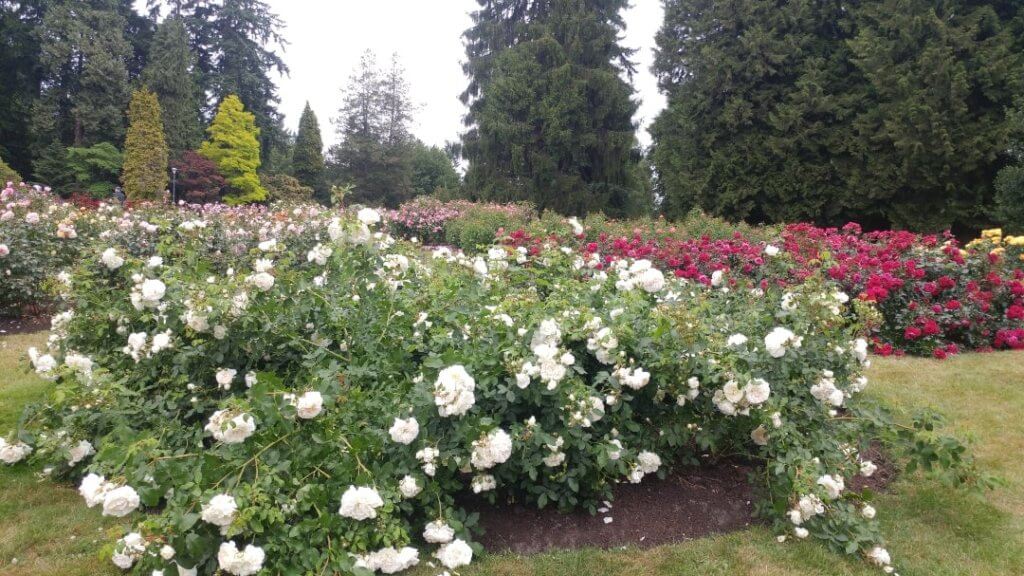
4. Harry Jerome Statue
The Harry Jerome Statue in Stanley Park is a bronze sculpture erected in 1986 to honor the legacy of Harry Jerome.
He was a Canadian track and field athlete who set several world records and won multiple medals during his career.
The statue depicts Jerome in a running stance and is located close to the area where Jerome often trained.
Jack Harman was the sculptor who created the statue which stands approximately nine feet tall on a granite pedestal.
Harry Jerome was born in Prince Albert, Saskatchewan, in 1940, and moved with his family to North Vancouver when he was young.
🦄 If you want more information about Vancouver, check out this blog post:
5 Things To Do In Vancouver If It’s Your First Visit

He began running track in high school and eventually became one of Canada’s most accomplished athletes.
Also, Jerome was an advocate for racial equality and social justice.
He spoke out against racism in sports and was a mentor to many young athletes, particularly those from marginalized communities.
He passed away in 1982 at the age of 42, but his legacy as a medal-winning athlete and advocate continues to inspire people around the world.
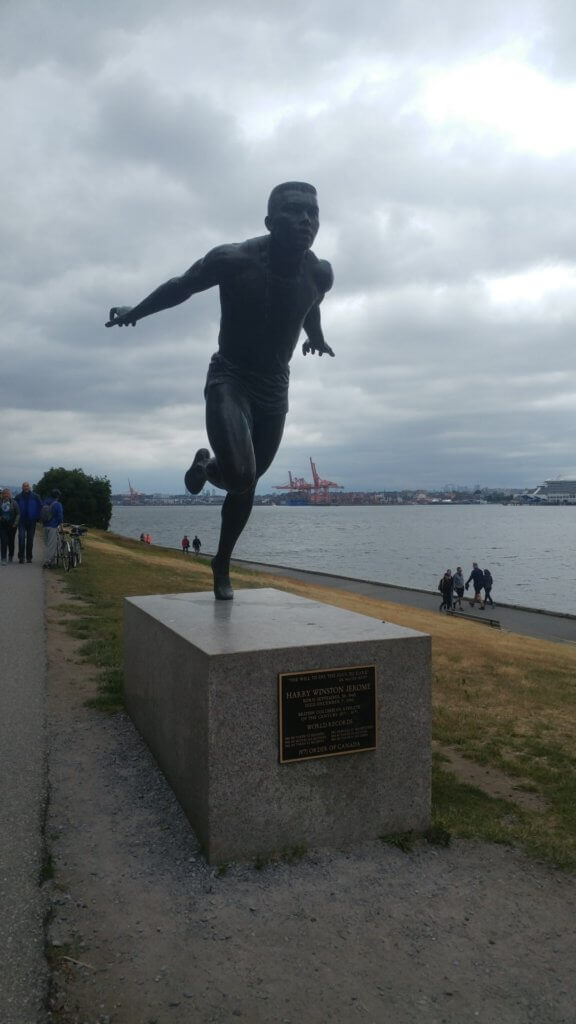
5. Nine O’Clock Gun
The Nine O’Clock Gun is a large naval cannon and a popular tourist attraction.
It is fired every night at 9:00 pm sharp, creating a loud boom that can be heard throughout the park and surrounding areas.
Unfortunately, we were in the park during the morning so we weren’t able to see it go off.
They store it during the day in a small pavilion protected from the elements.

The tradition of firing the gun dates back to 1894 when it was first used to signal the time to sailors and loggers in the area.
Today, it serves as a reminder of Vancouver’s maritime history and a way to mark the passing of time.
In addition to its nightly firing, the Nine O’Clock Gun is also used to mark special occasions, such as Canada Day and Remembrance Day.
The Nine O’Clock Gun even has its own Twitter page – @9oclockgun.

6. Brockton Point Lighthouse
The current version of the Brockton Point Lighthouse was built in 1914 and it’s named after Brockton Point, the name of the area on which it stands.
It was originally established at this location in 1890, due to the many boat accidents happening around the point.
Brockton Point and Lighthouse are named after the engineer Francis Brockton.
He discovered a coal deposit near Vancouver during his survey of the British Columbia coast aboard HMS Plumper in 1857 and 1860.
That led to Vancouver becoming a growing and prosperous city.
The lighthouse is a square, white tower with a horizontal red band across the middle, and a red lantern room on the top.
The base of the lighthouse is arched so that there is a walkway underneath it.
It stands over 10 meters (35 feet) tall and is at the northeast edge of Stanley Park.
From the lighthouse, you will see magnificent views of North Vancouver and Burrard Inlet.
The lighthouse was retired in 2005 but it is still a picturesque spot to take some stunning photos.

7. Totems at Brockton Point
The totems at Brockton Point in Stanley Park are a collection of First Nations totem poles.
Seeing the Totem Poles is one of the best things to do in Stanley Park.
The totem poles were originally carved by Indigenous Peoples from various nations across British Columbia.
They were erected in the park as a way to preserve and showcase Indigenous culture and art.
Today, the totem poles at Brockton Point are some of the most visited and photographed attractions in Stanley Park.
The collection includes several poles that were carved in the 1920s, as well as newer poles that have been added in recent years.
Each totem pole tells a unique story or represents a particular aspect of Indigenous cultures, such as family history, spiritual beliefs, or social status.
There is a total of nine totems and if you have never seen totem poles before you will be impressed at how beautiful and tall they are.
You will have to leave the Seawall and use one of the trails (follow the signs) to get to the totems, as they are a little bit inland.
They are about a 20 min walk on the Seawall from the Coal Harbour entrance to Stanley Park.

🦄 Related Vancouver blog posts:
Vancouver: Granville Island, VanDusen Botanical Garden & Kitsilano Beach
Vancouver: Gastown, Chinese Garden & Vancouver Lookout
10 Best Bakeries To Try In Vancouver, BC
Is It Safe To Drink Tap Water In Vancouver?
Is There Uber In Vancouver?
8. Girl in a Wetsuit
The Girl in a Wetsuit statue is a bronze sculpture that depicts a woman sitting on a rock, with one arm resting on her knee.
She is wearing a wetsuit, diving mask, and flippers and is gazing out toward the ocean.
Depending on the level of the tide, you will see a different amount of the rock where the statue is perched on.
The Girl in a Wetsuit was created by the Hungarian-born Canadian artist Elek Imredy in 1972.
Imredy based the statue’s pose on that of his friend, Debra Harrington, who served as the model for the sculpture.
It is often compared to Copenhagen’s Little Mermaid statue, as both sculptures depict a woman sitting on a rock near the water’s edge.
The statue has been the subject of some debate over the years.
Some have speculated that the woman is a mermaid, while others have suggested that she is a swimmer taking a break on a rock.
According to Imredy, he intended to sculpt a life-sized scuba diver on the rock as the sport was gaining popularity in Vancouver during that time.
Imredy denied the rumors, that Girl in Wetsuit was heavily inspired by the Little Mermaid in Copenhagen.
He wanted to create a sculpture that celebrated the natural beauty of the park and the importance of water to the city.

9. SS Empress of Japan Figurehead
The SS Empress of Japan Figurehead located in Stanley Park is a colorful fiberglass replica.
The original SS Empress of Japan Figurehead is available for viewing at the Vancouver Maritime Museum as part of its permanent collection.
It is a carved figurehead (decoration) from the bow of the SS Empress of Japan, a passenger ocean liner.

The Figurehead is an impressive work of art with a rich history that spans multiple continents.
The ship operated in the Pacific Ocean from the late 19th century to the mid-20th century.
SS Empress of Japan was also called the “Queen of the Pacific” as it crossed the Pacific over 400 times.
The ocean liner was decommissioned in 1922, and its figurehead was salvaged and brought to Vancouver.

10. Lumbermens’ Arch
It is a large, rustic-style wooden structure that was originally built in 1952 as a tribute to British Columbia’s logging industry.
It is also a little bit inland so you’ll have to follow the signs to find it.
Essentially, it is a single log propped up by two other logs, creating an arch.
Beside the arch, you will find the Lumbermens’ Arch Cafe, which serves burgers, fish and chips, hotdogs, coffee, hot chocolate, ice cream, etc.
Over the years, Lumbermen’s Arch has become an important landmark and gathering place in Stanley Park.
It is a popular place for a variety of events, including concerts, festivals, and cultural celebrations.

11. Beaver Lake
Beaver Lake is a unique and diverse wetland located within Stanley Park.
It is home to a variety of wildlife, including beavers, which can sometimes be seen swimming in the lake or building their lodges along the shoreline.
There is a large beaver dam in one section of the lake that you cannot miss.
The name “Beaver Lake” was given by European settlers who arrived in the area in 1907 and noticed the presence of beavers in the lake.
It is difficult to see any beavers during the day but if you visit either at dawn or dusk you will have better chances to spot one.

Also, there is a dam in the lake, which maintains the water level by controlling the rate of outflow from Beaver Lake.
Beaver Lake is located inland which means you will have to leave the Seawall and follow one of the trails to the lake.
The Beaver Lake Trail is about a 1 km long trail that completely encircles the lake.
This will add to your overall time in Stanley Park, only include it if you have plenty of time and are in good shape for the extra walking.
It is easier to walk this trail instead of biking it as its surface is made of compacted gravel.
Also, by walking you will have more time to enjoy the views and possibly spot one of the many animals that call Beaver Lake their home.
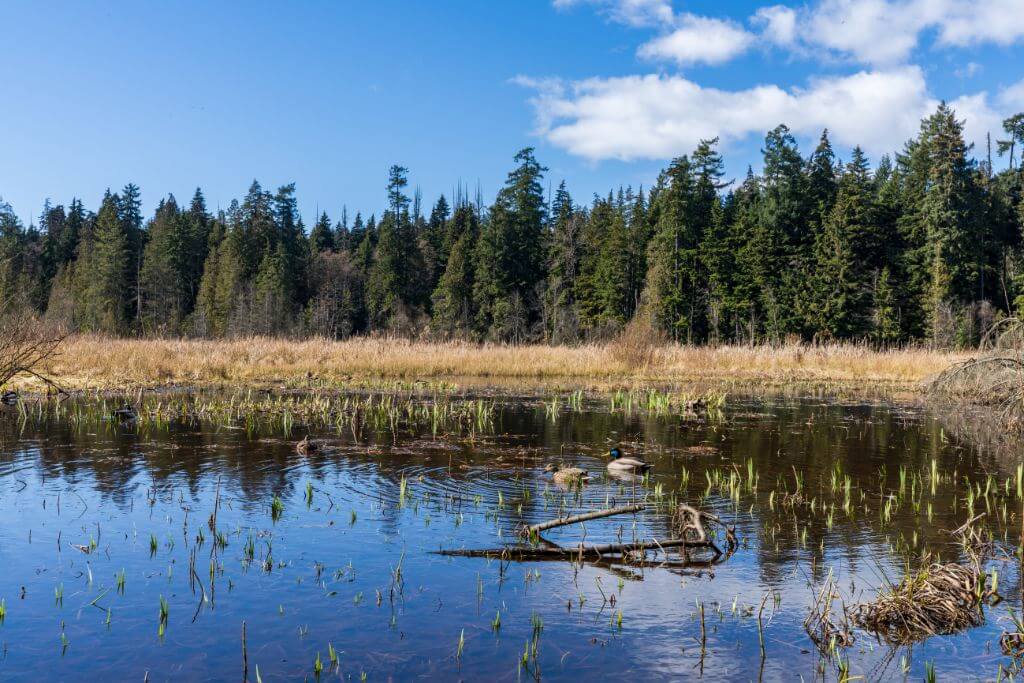
12. Lions Gate Bridge
It is the Canadian version of the Golden Gate Bridge in San Francisco but this one is greenish.
Its official name is First Narrows Bridge, but most people call it the Lions Gate Bridge.
The Lions Gate Bridge spans the Burrard Inlet, connecting the city of Vancouver to the North Shore municipalities of West Vancouver and North Vancouver
The bridge was completed in 1938 and was named after two mountain peaks on the North Shore, known as the Lions.
On the south entrance to the bridge, there are two statues of lions as well.
Can you walk across Lions Gate Bridge?
Yes, the bridge is open for pedestrian traffic, so you can walk on the bridge if you want.
There are sidewalks on both sides of the bridge.

If you are on Stanley Park’s Seawall you will pass underneath the bridge.
If you want to drive on the bridge, you need to go on the Stanley Park Causeway which goes through Stanley Park and then turns into the bridge.
The original purpose of building the Lions Gate Bridge was to provide a connection between Vancouver and the rapidly growing communities on the North Shore.
Before the bridge’s construction, the only way to travel between the two areas was by ferry.

The bridge’s construction played an important role in the development of the North Shore, opening up new opportunities for commerce and industry.
Today, the Lions Gate Bridge is an important transportation route in Vancouver.
It carries over 60,000 vehicles a day, as well as pedestrians and cyclists.
A distinctive landmark in Vancouver, the bridge is often featured in photographs and movies set in the city.

13. Prospect Point Lookout
Prospect Point Lookout is a scenic viewpoint on the northern side of the park.
It overlooks the Burrard Inlet, Lions Gate Bridge, and the North Shore Mountains.
The viewpoint is named after Prospect Point, a rocky headland that extends into the Burrard Inlet.
Prospect Point Lookout offers visitors stunning views of North Vancouver, West Vancouver, and different boats coming in and out of Burrard Inlet under the Lions Gate Bridge.
Keep in mind that walking up to the Lookout could be difficult due to the high elevation.

Also, there is a restaurant called Prospect Point Bar & Grill which has a lovely patio and offers appetizers, and burgers in addition to different alcoholic drinks.
If you need coffee, stop by the Prospect Point Cafe where you can grab their locally roasted Moja coffee.
As well as a variety of fresh baked goods, sandwiches, and salads.
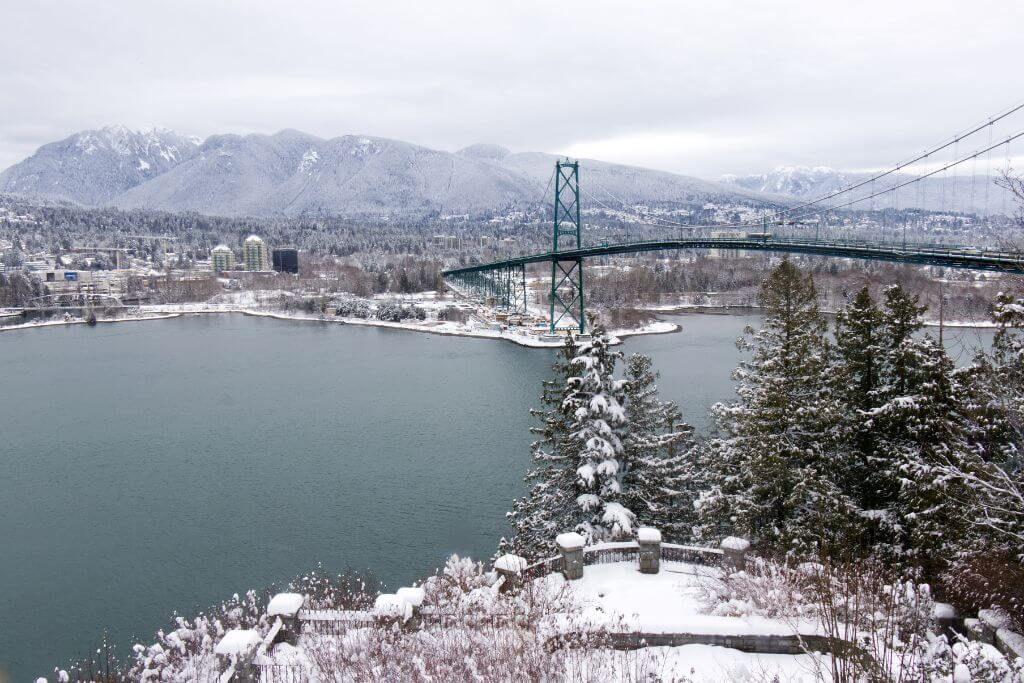
Also, there is a place to get some ice cream, which serves the locally-made Rocky Point Ice Cream.
Rocky Point produces ice cream in small batches using locally sourced products. Some of the flavors to try are Earl Grey & Honey, and Maple Walnut!
Lastly, there is a gift shop at the viewpoint – The Trading Post.
There you can find all sorts of Canadian souvenirs such as apparel, jewelry, and specialty food products such as maple syrup and smoked salmon.

14. Siwash Rock (Pineapple Rock)
Siwash Rock, also known as Pineapple Rock due to its shape, is a rock outcropping protruding from the waters beside Stanley Park.
The rock is near the park’s northern shore and is visible from several vantage points throughout the park.
It is a popular attraction and landmark in the area and it is one of the things to do in Stanley Park.
It’s composed of basalt, which is a type of volcanic rock that is common in the region.
The rock is approximately 18 meters (60 feet) tall and has a bunch of trees and shrubs growing on the top.

What is the story of Siwash Rock?
Siwash Rock is a sacred site by the Indigenous People of the area, the Squamish Nation, who refer to the rock as “Slhx̱í7lsh” in their language.
According to First Nations folklore, Siwash Rock is a representation of a warrior who was transformed into stone as a symbol of his devotion and purity towards fatherhood.
The legend tells the story of a young father who sacrificed everything to secure his child’s future.
The Squamish Nation requests that visitors to the rock show respect and refrain from climbing or otherwise disturbing the site.
Therefore, climbing the rock is not allowed so please stay on the Seawall!

🔔 Most of the attractions are located on the east side of the park’s Seawall (at the beginning of the park).
This means that if you are biking, you would probably have to get off your bike frequently to take pictures.
After Siwash Rock there is not that much to see in terms of man-made attractions.
Therefore, use this time to admire the beautiful nature and landscapes.

15. Hollow Tree
The Hollow Tree is a massive Western Red Cedar tree that is approximately 800 years old.
The base of the tree has a circumference of about 60 feet, and it is completely hollow on the inside, which allows visitors to enter and explore its interior.
It is located a bit inland, so you will have to leave the Seawall and follow the signs to find it.
The Hollow Tree has a long history and has been a popular attraction since the early days of Stanley Park.
In the past, people have had cars, horse-drawn carriages, and even an elephant inside the Hollow Tree for photos.

However, due to concerns about damage to the tree, this practice was stopped, and the tree was fenced off to protect it from further harm.
After a severe windstorm in 2006 caused damage to the tree, it was marked for removal as a safety precaution.
However, in 2009, the Hollow Tree Conservation Society emerged with a proposal to reinforce and secure the tree.
Today, visitors can still walk up to the tree and take pictures inside the hollow trunk.
🦄 If you want more information about other nature-related activities to do in Vancouver, check out this blog post: Vancouver: Capilano Suspension Bridge, Grouse Mountain & Lynn Canyon

16. Third Beach
There are three main beaches in Stanley Park. They are Third Beach, Second Beach, and First Beach (also called English Bay Beach).
As you are walking or biking the Seawall you will encounter them in that order.
Third Beach is located on the park’s western side.
It is a large beach with a sandy shoreline, a grassy area for picnicking, and a concession stand.
You can swim in the water but keep in mind that the water is usually cold even in the summer months.

Also, it gets deep quickly so unless you are a great swimmer, you probably should not stray too far from the shore.
There is a lifeguard on-site only during the summer months.
Unfortunately, there is not much parking available in Stanley Park so I would recommend walking there or biking.
Third Beach is the quieter and least crowded of the three as it is furthest from the city.

17. Second Beach
Second Beach is smaller compared to Third Beach but it is more family oriented.
Families enjoy this beach as it has a lot of green areas as well as two playground areas for children.
Second Beach is also on the western side of Stanley Park, south of Third Beach.
The beach features a large, heated, outdoor swimming pool that is open from May to September each year.

Also, there are picnic tables and barbecue pits available for public use.
At night, Second Beach often hosts outdoor festivities, fireworks, and movie screenings during the summer months.
Second Beach is a popular destination for families, swimmers, sunbathers, and those who enjoy outdoor activities and events.

18. First Beach (English Bay Beach)
First Beach, also known as English Bay Beach, is one of the most popular beaches in Vancouver.
It is located on the western side of Stanley Park, a few minutes walk from the downtown core.
First Beach is situated a little bit after the park ends. You will see more people here because we are more or less back in the city.

The beach is along the shores of English Bay, and it offers stunning views of the ocean and the surrounding mountains.
First Beach is a great spot for sunbathing, swimming, beach volleyball (two courts), and other water sports.
Also, there are many amenities available, including washrooms, concession stands, beach umbrella and chair rentals, kayak rentals, etc.

The Stanley Park Seawall surrounds the beach, making it perfect for jogging, cycling, or strolling while enjoying the views.
The lively atmosphere of the beach attracts locals and tourists alike, especially during the summer months.

19. A-maze-ing Laughter Figures
The A-maze-ing Laughter Figures are a public art installation located in Morton Park.
The installation consists of 14 bronze sculptures of bald, men in various poses of laughter, created by the Chinese artist Yue Minjun.
The installation is located at the beginning of First Beach (English Bay Beach) and it’s in the middle of an intersection.
The figures are each approximately three meters tall and weigh over 250 kilograms.
They are standing in a large circle, inviting visitors to walk among them and interact with them.
The sculptures are intended to be playful and whimsical, but also to convey a deeper message about the importance of laughter and happiness in our lives.
The A-maze-ing Laughter Figures have become a popular tourist attraction in Vancouver since their installation in 2009.
They have been widely photographed and shared on social media.
A-maze-ing Laughter Figures remain a unique and memorable feature of Vancouver’s public art scene, and they continue to draw crowds of visitors to Morton Park year-round.

20. Inukshuk
An inukshuk is a traditional stone landmark popular with the Inuit and other Indigenous Peoples of the Arctic region.
The Inukshuk is a large stone sculpture located on the shores of English Bay.
It is a structure made out of individual stones, organized to resemble a human shape.
The Vancouver Inukshuk was created by the artist Alvin Kanak in 1986 as part of the Expo ’86 World’s Fair.
The sculpture, made of granite stones, stands over six meters tall. However, inukshuks are usually way smaller (not taller than your hip).
They are smaller because it is difficult to balance the stones on top of each other, as no glue or substance is holding them together.

The word “inukshuk” translates to “something that resembles a human” in the Inuit language.
Constructing an inuksuit involves using whatever rocks are available at the location, resulting in each inukshuk being unique and one of a kind.
What is the meaning behind an inukshuk?
Inukshuks have been used to signify a particular spot for navigation purposes or to highlight a significant place, like a burial site.
By pointing their arms and legs in a specific direction, they are also used as navigational aids, indicating the direction to travel.
Also, the inukshuk is a symbol of warmth, kindness, and companionship that is commonly associated with Northern communities.

🔔 Continuing biking down the Seawall after the Inukshuk, you will eventually get to Granville Island.
If you do not wish to continue down the Seawall after Second Beach (it is a lot of biking in one day, especially if you are not used to it), you can turn towards the Lost Lagoon and get back to exactly where you started.
If you rented your bike, you would have to go back towards the Lost Lagoon as all of the bike-renting places are located right by the entrance to the park.
Map Of The Things To Do In Stanley Park

FAQs: Things To Do In Stanley Park
Here are some of the most FAQs regarding Stanley Park and Vancouver.
What you should know before going to Vancouver?
Vancouver has a mild climate, with average temperatures hovering around 20°C during the summer and dropping to approximately 5°C in the winter.
Since it rains frequently, it is advisable to bring a waterproof jacket, umbrella, and rain boots.
Additionally, Vancouver is a multicultural city, home to a diverse population where English serves as the primary language, although other languages are also commonly spoken.

The currency in Vancouver is Canadian dollars, and credit cards are accepted everywhere.
Finally, Vancouver’s natural beauty is well-known, with mountains, forests, and beaches within easy access.
Take advantage of the various outdoor activities available, such as hiking, skiing, and kayaking.

What is the best time of year to visit Vancouver?
The ideal time to visit Vancouver varies depending on your interests and preferences.
The summer season (June to August) is the most sought-after time of year to visit Vancouver, thanks to the warm temperatures and an abundance of outdoor activities to indulge in.
In addition, the city hosts various festivals and events throughout the summer, such as the Vancouver International Jazz Festival and the Celebration of Light fireworks competition.

Fall (September to November) is another fantastic time to visit Vancouver, with milder temperatures and fewer tourists.
The city’s parks and gardens come alive with vibrant colors from fall foliage and blooms, making it a perfect season to enjoy nature’s beauty.
Winter (December to February) is an excellent season to visit if you are into winter sports, such as skiing and snowboarding, as Vancouver is located near several ski resorts.

Also, the city celebrates the festive season with holiday markets and events, such as the German Christmas Market and the Festival of Lights at VanDusen Botanical Garden.
Spring (March to May) may experience occasional showers, but it’s the perfect time to witness the blooming of cherry blossoms and other spring flowers.
Moreover, this season is relatively quieter, with lower hotel rates and fewer crowds.
All things considered, Vancouver is a year-round destination with a lot to offer in every season.

Why is Stanley Park so famous?
Stanley Park is famous for its abundant natural beauty, cultural significance, and wide range of attractions and activities available.
The stunning natural beauty of the park is one of its main appeals, located on a peninsula surrounded by the Burrard Inlet and English Bay waters.
The park offers spectacular views of the city skyline and the North Shore Mountains.
It is home to old-growth forests, scenic trails, and beaches, making it a popular destination for outdoor enthusiasts.

Also, the traditional lands of the Coast Salish people host Stanley Park, rendering it culturally significant.
Therefore, it is home to several totem poles and other Indigenous artworks.
The park’s history and heritage are celebrated through a variety of interpretive programs and events.
Finally, Stanley Park is famous for its numerous attractions and activities.
Visitors can enjoy a variety of experiences, including cycling and rollerblading on the Seawall.
As well as visiting the Vancouver Aquarium, exploring the park’s gardens and beaches, and taking a horse-drawn carriage ride through the forest.
All of these factors contribute to the park’s reputation as one of Vancouver’s must-see destinations.

How much does it cost to get into Stanley Park?
There is no admission fee to enter Stanley Park. The park is open to the public and free to access year-round.
However, there could be fees for specific attractions and activities within the park.
For example, if you want to visit the Vancouver Aquarium, which is located in Stanley Park, there is an admission fee.
In addition, there could be fees for other activities within the park, such as bike rentals, guided tours, etc.

What is the Seawall in Stanley Park?
The Seawall is the world’s longest uninterrupted waterfront path.
It is the most popular trail within the park and runs along the park’s waterfront.
The Seawall is a flat, paved pathway that offers a comfortable and easy walk for visitors.
Additionally, the road divides into two sides – one for pedestrians and the other for bikers.
How long is the Stanley Park Seawall?
Stretching around 10 km (6.2 miles), the Seawall provides breathtaking views of the city skyline, the North Shore Mountains, and the ocean.

How long does it take to walk around Stanley Park?
At a leisurely pace, walking the entire perimeter of Stanley Park (the Seawall) typically takes around 2-3 hours.
However, the duration may vary based on the number of stops made along the way to appreciate the scenic beauty or visit the park’s various attractions.
👉 If you prefer to do an organized walking tour, check out this option: Vancouver Secrets of Stanley Park Walking Tour
Numerous trails and pathways meander through the gardens, forests, and waterfront areas of Stanley Park.
They offer visitors an up-close experience of the park’s natural splendor.
As a result, visitors can decide to explore particular sections of the park and take shorter walks based on their preferences.
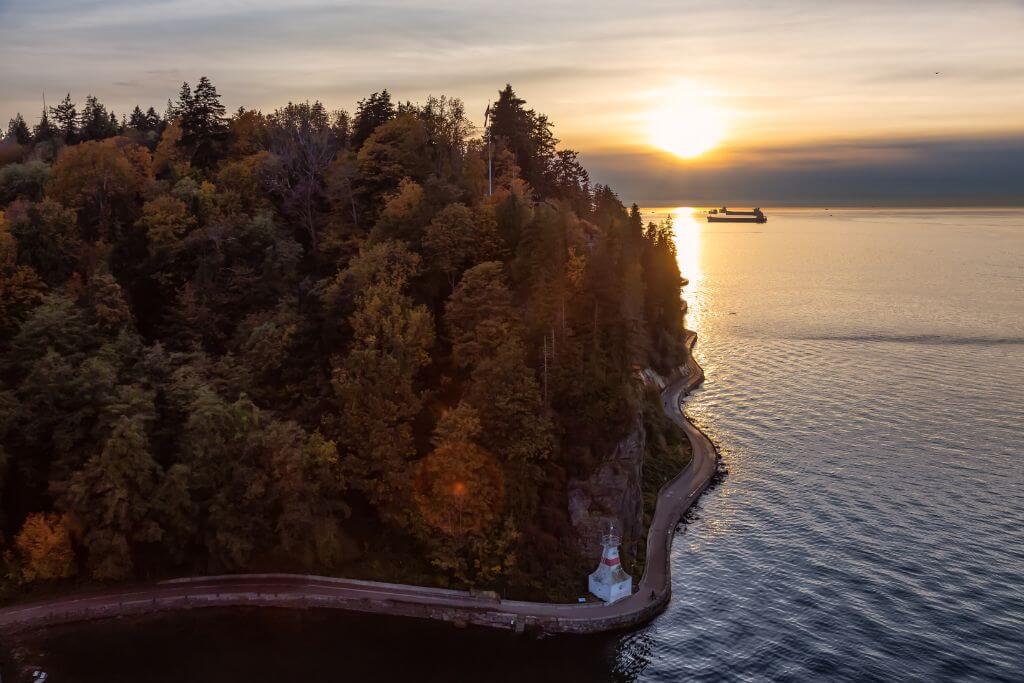
How long does it take to bike the Seawall?
Biking the entire length of the Seawall in Stanley Park typically takes around 1-2 hours.
The pathway is wide enough to accommodate both cyclists and pedestrians, and there are several designated rest areas and lookout points along the way.
However, it’s important to note that the Seawall can be busy, especially during peak tourist season.
👉 If you are looking for an organized biking tour around Staley Park, here is a good option: Vancouver: Stanley Park Bicycle Tour

Hotels Near Stanley Park
There are many hotels in Vancouver, however, there are not that many that are located close to Stanley Park.
Having said that, below you will find my two recommendations, the first one is more on the budget side and the second is more luxurious.
Times Square Suites Hotel
- Times Square Suites Hotel is a budget option with over 1,684 reviews and 9.2 ratings
- It is located 1.2 km from Stanley Park and bike rental shops, Starbucks, and an Italian restaurant are located below the apartments
- This property has spacious, fully furnished suites with fully equipped kitchens and gas fireplaces, a rooftop patio with stunning views
- Free WiFi available, paid parking at CAD 30 per day
👉 Check availability for your dates: Times Square Suites Hotel
The Westin Bayshore
- Waterfront resort-style property with newly renovated guestrooms with floor-to-ceiling windows offer stunning views of the harbor, mountains, and city skyline
- The Westin Bayshore is located 1.5 km away from Stanley Park, 1,000 meters from Burrard Metro Station
- Features an outdoor (heated) and indoor pool, an on-site spa, a fitness center
- Also, has Free WiFi throughout the property; paid parking for CAD 45 per day
👉 Check availability for your dates: The Westin Bayshore, Vancouver
Conclusion: 20 Things To Do In Stanley Park, Vancouver
In conclusion, there are endless things to do and see in Stanley Park, and biking around the park is an excellent way to experience it all.
Biking around the park is manageable even for those who are not athletic.
It’s an adventure with plenty of stops along the way to take pictures, appreciate the natural beauty, and visit the park’s many attractions.
Overall, visiting Stanley Park is a must-do experience for anyone visiting Vancouver.
🦄 Also, if you want more information about Stanley Park and how to rent a bike, check out this blog post: Biking Stanley Park, Vancouver + 7 Best Bike Rentals





